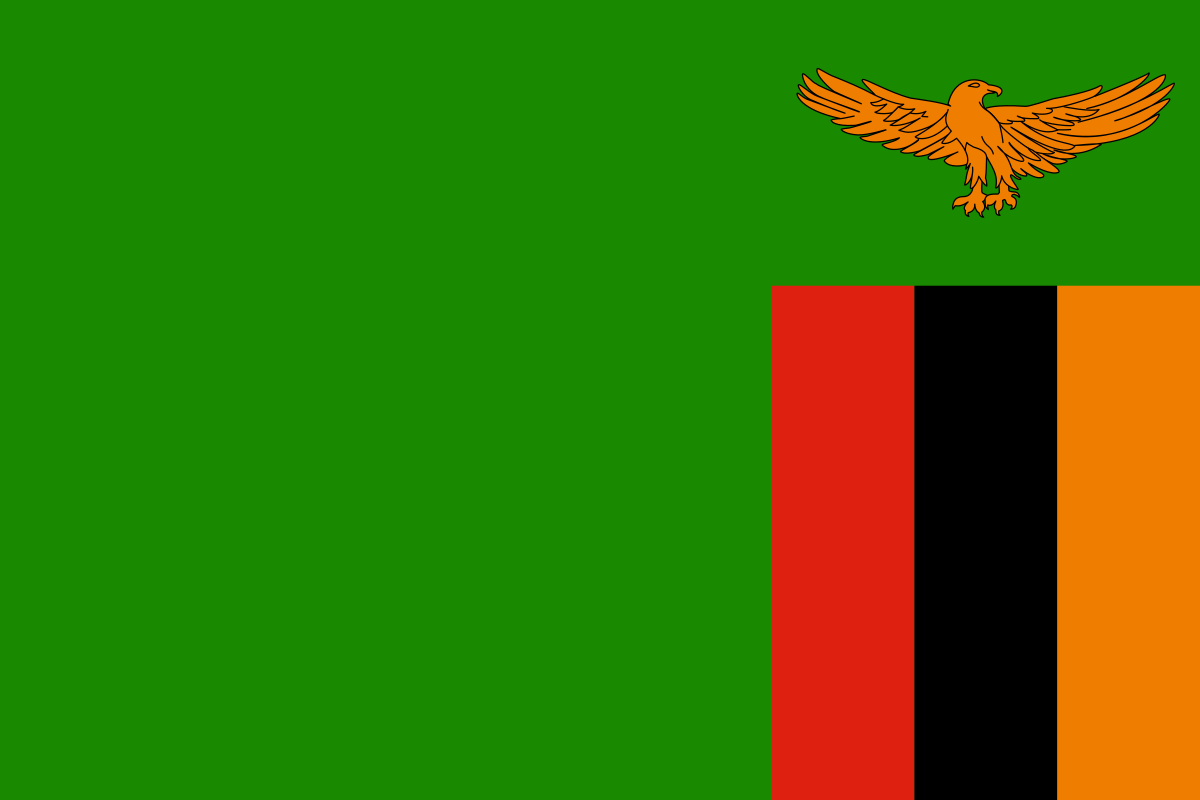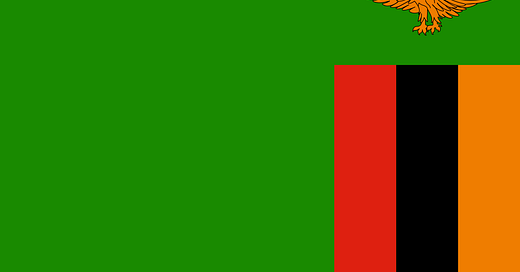Zambia
Hello, Fanatics! It’s been quite awhile since I posted, and I apologize for the absence. With the year coming to a close, I think it’s only fair that I post before 2023. Today, I bring to you another Flag Review on a national flag, the flag of Zambia! Read on as we explore this African nation.
Zambia is a landlocked country located in the southern portion of the African continent. It shares borders with eight nations, including Angola to the west, the Democratic Republic of Congo to the north and Malawi to the east. The country holds many scenic landscapes and, despite its large population, most of the country remains uninhabited.
Zambia was first inhabited by a multitude of people generally known as the Khoisans. The Bantu Expansion at the start of the first millennium led many people from North Africa to settle in the region currently known as Zambia. This migration also brought more modern agricultural practices. By the 16th and 17th centuries, established kingdoms became more apparent in the region. Around one hundred years later, the first European explorers would visit the region now known as Zambia.
Interest in Africa by European nations in the 18th and 19th century for the continent’s resources led to Zambia’s eventual colonization by the British Empire. The British South Africa Company was chartered in 1889 to mine for gold in southern Africa. The company would grow to form two British colonies by the early 1920’s, Southern Rhodesia (modern-day Zimbabwe) and Northern Rhodesia (modern-day Zambia).
In 1953, a Federation was created between Northern Rhodesia, Southern Rhodesia, and Nyasaland (another British colony which would become modern-day Malawi). However, support for the Federation did not last and as opposition grew, so did North Rhodesia’s desire for independence. On October 24, 1964, North Rhodesia officially became the Republic of Zambia, an independent and sovereign country. Despite its freedom from colonial rule, the nation experienced turbulent years post-independence, brought about by internal fighting and political strife in neighboring countries and colonies. The first elected president of Zambia, Kenneth Kaunda, ruled the country from its independence in 1964 until 1991. His time in office was marked by poor management of existing infrastructure as well as a tyrannical government with one-party rule. Despite the large number of natural resources in the country, the mismanagement by the Kaunda regime and the increasing economic problems of the country led to growing opposition against Kaunda in the 1990s. Nation-wide protests sparked by the Kaunda regime’s violent suppression of its opposition forced Kaunda to permit multi-party elections. In the 1991 presidential election, Frederick Chiluba was elected the president of Zambia, ending Kaunda’s 27 year reign.
After a decade of further instability in the 1990’s, Zambia experienced economic growth in the early 2000’s. Part of this growth was due to increases in worldwide copper prices (copper being the biggest export of Zambia). While present-day Zambia has been criticized for its poor human rights laws and limited free speech, the country continues to see economic growth, in large part due to foreign investors looking to capitalize on Zambia’s rich natural resources.
Natural resources are a great segue for exploring Zambia’s flag. Let’s dig into this, may I say, unique national flag.

The flag of Zambia was designed by Gabriel Ellison, a graphic designer from Lusaka (the capital of Zambia). It was first flown when Zambia gained independence in 1964. Slight modifications were made to the flag’s colors and eagle in 1996, but the main flag design remained unchanged.
The flag’s proportions are 3:2, a fairly common ratio for national flags. It consists of a green field; the green in the flag’s original design in 1964 was darker than the green used in today’s official design. Sitting atop the field, on the upper fly of the flag, is an orange eagle. Below the eagle, on the lower fly, is a three-color rectangle of (from hoist to fly) red, black, and orange vertical stripes. For a more exact description of the flag, here is an excerpt from Zambia’s National Flag and Armorial Ensigns Act:
“Green with an orange coloured eagle in flight over a rectangular block of three vertical stripes coloured from left to right in red, black and orange; of overall dimensions 3:2”
I will note that this same Act makes any insult of the flag an offense punishable by up to two years in prison. It also limits a Zambian’s personal display of the national flag to special holidays only, unless special permission is given by the government. There are actually a lot of restrictions to using the flag, with many offenses punishable by jail time.
While most flags typically place charges and emblems on the upper hoist (canton) of the flag, Zambia’s unusual design places the eagle and rectangular charge on the fly. It is said that the reason for placing charges and emblems closer to the hoist is for identification of worn flags; when a flag is flown outdoors, such as on a ship, and exposed to the weather for long periods of time, the fly tends to wear before the hoist. By placing charges on the canton, even when a flag’s fly is tattered, the flag is still identifiable. If the flag were to rip or tear on the end of Zambia’s flag, it might be difficult to identify it from a far distance, making its design somewhat impractical. However, I think it gives the flag character. No doubt people might disagree with me, but in my opinion, Zambia’s placement of the eagle and three-color rectangle gives the flag some character in a world of flags that can sometimes become stale, with the same patterns used ad nauseam (how many national tricolor flags can we have before they all start to look identical?).
As for the colors used in the flag: according to some of the sources I found on the flag of Zambia, the orange eagle on the upper fly symbolizes the nation’s ability to overcome hardships. The vertical stripes below the eagle hold the following meanings: red for the country’s fight for independence, black for the Zambian people, and orange for the abundant minerals. The flag’s green field represents the nation’s natural resources, which is fitting, as the country is home to Victoria Falls, one of the seven natural wonders of the world.
Far too often, I feel that flag designs can become a blob of the same patterns used over and over again and they get lost in an endless sea of bland, boring flags. The flag of Zambia breaks from the norm and gives us an original design that makes the viewer pause and ask, “What is that flag?” I won’t argue that the color palette of the flag is my favorite (it’s not by any means), but Ellison’s flag design does something that not many flag designs do: it makes us question if there really are rules for good flag design.
Thanks for reading. Have a Merry Christmas and see you in 2023!
Sources
Central Intelligence Agency. (n.d.). Libya. The World Factbook 2021. https://www.cia.gov/the-world-factbook/countries/zambia/
The Flag of Zambia | Embassy of the Republic of Zambia in Washington, D.C. (n.d.). Embassy of Zambia. Retrieved December 12, 2022, from https://www.zambiaembassy.org/page/the-flag-of-zambia
Gabriel Ellison, the woman who assisted in designing the national flag died this week. (2017, July 21). Lusaka Times. https://www.lusakatimes.com/2017/07/21/gabriel-ellison-woman-assisted-designing-national-flag-died-week/
History. (n.d.). Copperbelt Provincial Administration. Retrieved December 12, 2022, from https://web.archive.org/web/20211205115558/https://www.cbt.gov.zm/?page_id=4385
The National Flag and Armorial Ensigns Act. Chapter 6 (1994). Ministry of Legal Affairs, Government of the Republic of Zambia. Retrieved December 12, 2022, from https://www.parliament.gov.zm/node/688
Republic of Zambia. (n.d.). CRW Flags. Retrieved December 12, 2022, from https://www.fotw.info/flags/zm.html
Zambia History. (n.d.). Zambia Tourism. Retrieved December 12, 2022, from https://www.zambiatourism.com/about-zambia/history/
Znamierowski, A. (2020). The World Encyclopedia of Flags. Lorenz Books.




